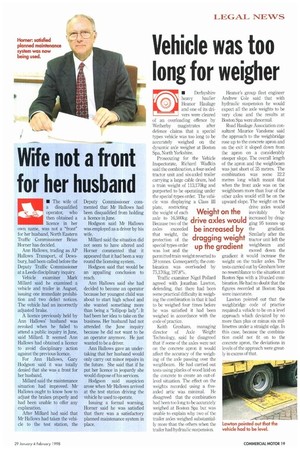Vehicle was too long for weigher
Page 21

If you've noticed an error in this article please click here to report it so we can fix it.
• Derbyshire heavy haulier Heanor Haulage and one of its drivers were cleared of an overloading offence by Wetherby magistrates after defence claims that a special types vehicle was too long to be accurately weighed on the dynamic axle weigher at Boston Spa, North Yorkshire.
Prosecuting for the Vehicle Inspectorate, Richard Wadkin said the combination, a four-axled tractor unit and six-axled trailer carrying a large cable drum, had a train weight of 113,170kg and purported to be operating under the special types order. The vehicle was displaying a Class III plate, restricting the weight of each axle to 16,500kg. Because two of the axles exceeded that weight, the protection of the special types order was lost and the permitted train weight reverted to 38 tonnes. Consequently, the combination was overloaded by 75,170kg, 197.8%.
Traffic examiner Nigel Pollard agreed with Jonathan Lawton, defending, that there had been some practical difficulty in weighing the combination in that it had to be weighed four times before he was satisfied it had been weighed in accordance with the code of practice.
Keith Gresham, managing director of Axle Weight Technology, said he disagreed that if some of the axles were not on the concrete apron it would affect the accuracy of the weighing of the axle passing over the weighbeam. He had carried out tests using planks of wood laid on the concrete to create an out-oflevel situation. The effect on the weights recorded using a fiveaxled artic was minimal. He disagreed that the combination had been too long to be accurately weighed at Boston Spa but was unable to explain why two of the trailer axles weighed substantially more than the others when the trailer had hydraulic suspension_ Heanor's group fleet engineer Andrew Cole said that with hydraulic suspension he would expect all the axle weights to be very close and the results at Boston Spa were abnormal.
Road Haulage Association consultant Maurice Vandome said the approach to the weighbridge rose up to the concrete apron and on the exit it sloped down from the apron on a considerably steeper slope. The overall length of the apron and the weighbeam was just short of 35 metres. The combination was some 22.2 metres long which meant that when the front axle was on the weighbeam more than four of the other axles would still be on the upward slope. The weight on the drive axles would inevitably be increased by dragging 95 tonnes up the gradient. Similarly after the tractor unit left the weighbeam and moved down the gradient it would increase the weight on the trailer axles. The tests carried out by Gresham bore no resemblance to the situation at Boston Spa with a 10-axled combination. He had no doubt that the figures recorded at Boston Spa were inaccurate.
Lawton pointed out that the weighbridge code of practice required a vehicle to be on a level approach which deviated by no more than plus or minus six millimetres under a straight edge. In this case, because the combination could not fit on to the concrete apron, the deviations in levels of the approach were greatly in excess of that












































































































